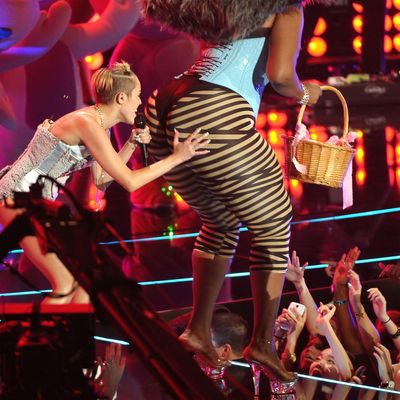
You’d be forgiven for wearying of essays about Miley Cyrus — her “disgusting” raunchiness, her “careerist” minstrelsy, and her ratchet cultural appropriation. You’d be justified in feeling shocked that a manufactured awards-show controversy has hijacked the national conversation during a week when we might go to war. But if you have one more think piece in you, I recommend Emory sociology Ph.D. student Tressie McMillan Cottom’s essay “When Your (Brown) Body Is a (White) Wonderland.”
Published on her personal website, it has been making the rounds on Twitter since last night (h/t @pushinghoops). Cottom homes in on Cyrus’s choice to shake her nonexistent butt while surrounded by “rotund” black female backup twerkers who specifically do not look Rihanna. “It’s a dance between performing sexual freedom and maintaining a hierarchy of female bodies from which white women benefit materially,” she explains — a way of playing along without actually competing.
Cyrus acts out her faux bisexual performance for the white male gaze against a backdrop of dark, fat black female bodies and not slightly more normative cafe au lait slim bodies because the juxtaposition of her sexuality with theirs is meant to highlight Cyrus, not challenge her supremacy. Consider it the racialized pop culture version of a bride insisting that all of her bridesmaids be hideously clothed as to enhance the bride’s supremacy on her wedding day. Only, rather than an ugly dress, fat black female bodies are wedded to their flesh. We cannot take it off when we desire the spotlight for ourselves or when we’d rather not be in the spotlight at all.
Cottom also describes her experiences as a sexual punch line to drunk, white college guys (and their non-threatened white girlfriends) in Atlanta. It’s provocative stuff, and not in the Miley sense.





